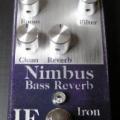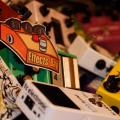The following is a guest post by Mike Emiliani of Smart Bass Guitar. If you are interested in guest posting, please contact me!
Buying Effect Pedals: My Love-Hate Relationship
I’m a huge fan of bassists who do new and exciting things on bass guitar. Thundercat, Squarepusher and even younger, more niche players like Nathan Navarro, and Eric Hyland from Cosmic Dust Bunnies are just some of the names that I believe are really stand out players in bass guitar both in how they play and how they’ve made the most of the instrument. I’d argue these musicians use of effect pedals is what really does bring their music to life in a larger way.
Periodically, I’ll get a stroke of inspiration from listening to these artists and feel inclined to purchase some pedals of my own. However, once the pedal is purchased it quickly becomes a nuisance in my life. The need for additional electronics to keep it alive and functioning, having to take it from show to show, having to find more cables and more gizmos to work the thing into a set and so on. The excitement of owning and playing with a new pedal soon wears off and is replaced by frustration and buyer’s remorse.
So goes the story of my love-hate relationship with effect pedals.
Shiny New-ish Pedals
The possibilities of effect pedals to take my music to another level is always an attractive thought but the realities are not so glamourous. As I mentioned before, the kick starter for me to get a new pedal is a spur of inspiration from some source. I’ll hear a particular sound or covet a particular tone and absolutely engross myself in it to the point that a purchase is all but inevitable. After a look-over of a few Amazon reviews, I’ll head over to eBay or Guitar Center used and check out the deals. If I find what I’m looking for, I’ll make a purchase then and there.
The package arrives and I unbox the pedal and plug it in. Like anyone with a new toy, excitement is all I’m experiencing right now. Excitement to plug it in, excitement to write some material around it and excited to just mess around with it and see what comes out.
But slowly, that excitement fades. The reality of the purchase begins to set in and the frustrations begin to set in. The batteries that power the pedal die frequently and it costs money to replace them, sometimes the pedal won’t work properly despite being plugged in properly – simple things that might not bother the hardcore pedal user or collector start to eat away at me taking the idealistic fun out of the playing experience.
Moreover, the looming feeling that additional purchases to support this pedal and the prospect of more pedals is not a comforting thought. Pedals and pedal gear is not cheap – even used. A power brick, pedal train, amp cables, patch cables, other widgets and gizmos and just other pedals to complement existing pedals that will aid in helping me express the sounds inside my head all come with a sizeable price tag that, quite frankly, doesn’t sound at all attractive.
The realities of owning, maintaining and just working with pedals as a bass player to me slowly seemed like more hassle than it was worth.
About a month passes by and the zeal of the new pedal has passed. I put it up on eBay, sell it off and get some of my money back. Rinse and repeat for a handful of years.
Love and Hate
While I love the musical benefits that having pedals delivers, it’s the practical elements of owning pedals that turns me away from being a serial pedal collector.
The sounds and musical potential that come from tying pedals together in different orders with different settings is a very attractive thought. But the reality of the hundreds of dollars that need to be spent to be able to have the ability to make a soundscape on bass guitar plus all the additional time of setting up and packing up the pedals show to show plus the reliance on them for certain songs and critical components of a live set that emerges is now and always has been enough to turn me off from being a serious pedal owner and user.
As a result of this, I’ve noticed myself become a little bit more crafty when it comes to expressing complex, holistic musical ideas on bass guitar. The biggest of these ideas is turning to production with programs like Maschine and Apple’s Logic to create the sonic landscapes I’ve heard in my head and then EQ the live bass into the track ala Squarepusher or Thundercat.
It’s a textbook love-hate relationship I’ve created for myself over the years when it comes to pedals: the musical possibilities clash with the financial obligation and the routine maintenance and upkeep.
Conclusion
While some people aren’t at all bothered by things and maybe I’m in the minority in this mindset, it’s certainly a view that has kept creeping back up on me over the years and reeled me back in from having used pedals extensively.
I think Keith Richards said it best when asked what his guitar rig is and he replied that all he needs is his guitar and his amp.
– – – –
Mike Emiliani is a bass player, beatmaker and founder of the bass guitar blog, Smart Bass Guitar, a twice-weekly bass guitar-centered site for interviews, free downloads and learning hacks for bass players.
-
10 years ago
Ya, its true, all Richards needs is his guitar and amp…except for when he’s gotta play one of his signature songs like Satisfaction that was probably birthed from playing around with his new Maestro FuzzTone 😉
Reply -
10 years ago
I’m in exactly the same boat. My pedals are cumbersome a lot of the time and don’t always replicate the sound I’m trying to achieve when hooked into my setup.
Reply -
10 years ago
Hey theres a typo, bass player of Cosmic Dust Bunnies is Matt Beckett, Eric Hyland is the drummer
Reply




